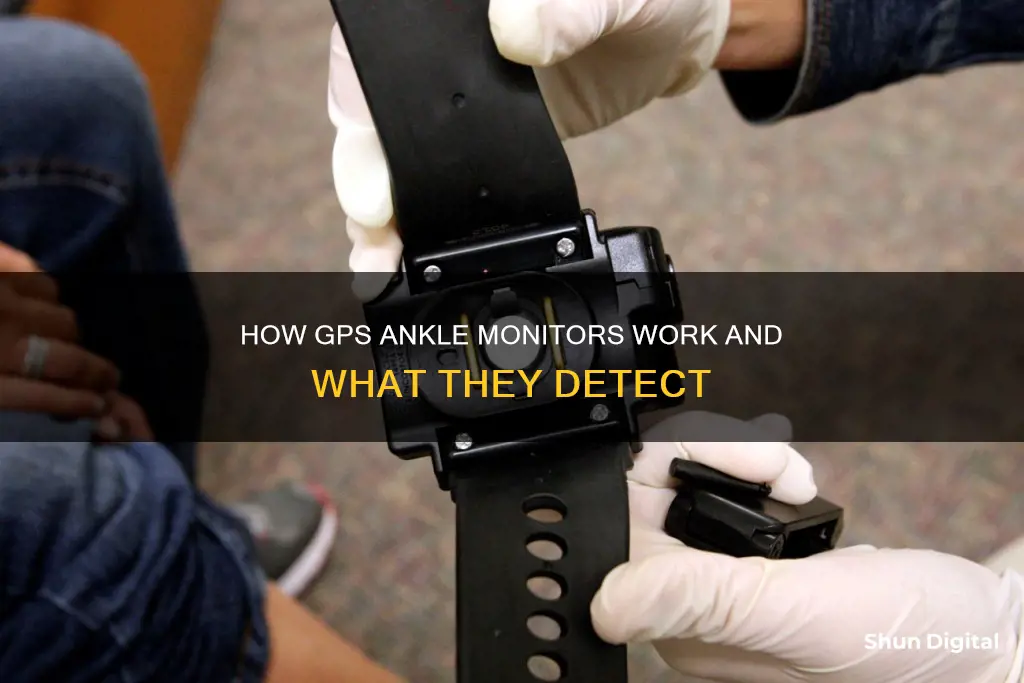
GPS ankle monitors are used as an alternative to full-time incarceration, allowing the corrections system to monitor offender behaviour and location. The device is strapped to the ankle and uses GPS technology to track the wearer's movements, sending a constant signal to a base unit, usually located in the home. This allows the wearer to remain free while awaiting trial, provided they meet certain conditions set by the court. GPS ankle monitors can be used to ensure the wearer stays within a certain radius of their home, maintains a required distance from a victim, or abides by a curfew. The device can also be used to detect alcohol consumption by testing the wearer's sweat.
| Characteristics | Values |
|---|---|
| Purpose | To monitor offender behaviour without requiring full-time incarceration |
| Type of technology | Radio Frequency (RF), GPS, Cellular Unit or Receiver |
| Features | Waterproof, shock-resistant, long-lasting battery |
| Placement | Ankle is the preferred location |
| Tracking | Pinpoints location every minute or so |
| Alerts | Sent when the wearer ventures outside the restricted area |
| Communication | Two-way communication system between the offender and the corrections officer |
| Additional features | Monitoring of sweat from the skin to determine alcohol consumption |
What You'll Learn
- GPS ankle monitors can detect if the wearer enters/leaves a specific location, like their residence
- They can be used to ensure the wearer maintains a required distance from a victim
- They can detect alcohol consumption by testing the wearer's sweat
- GPS ankle monitors can be used to ensure the wearer doesn't approach schools
- They can be used to ensure the wearer doesn't approach the victim's home or workplace

GPS ankle monitors can detect if the wearer enters/leaves a specific location, like their residence
GPS ankle monitors are used as an alternative to full-time incarceration, allowing the corrections system to monitor offender behaviour and ensure they don't reoffend. They are often used for people who are awaiting trial and are considered a danger to the community or a flight risk.
GPS ankle monitors can detect if the wearer enters or leaves a specific location, such as their residence. This is done through a combination of GPS satellites, cellular towers, and/or Wi-Fi. The GPS receiver in the ankle monitor detects signals from GPS satellites, providing a location that is then transmitted via a cellular connection to a central monitoring hub. This allows for real-time tracking of the wearer's movements and can be used to ensure they are adhering to any conditions set by the court, such as a curfew or specific areas they are allowed to be in.
For example, a wearer may be allowed to go anywhere within a certain radius of their home. The monitor will track their movements within this area, but if they go outside of it, an alert will be sent to the relevant authorities. This technology is known as geofencing and is used to define restricted areas for the wearer. It can also be used to ensure that the wearer maintains a required distance from a victim or certain individuals.
GPS ankle monitors provide an opportunity for individuals to maintain some level of normalcy in their lives while also being held accountable for their actions. They are a tool to balance the need for supervision and community safety with the recognition that incarceration may not be the most effective solution in every case.
Monitor Size and Eyesight: Is There a Connection?
You may want to see also

They can be used to ensure the wearer maintains a required distance from a victim
GPS ankle monitors are often used as an alternative to pre-trial detention or as a condition of probation. They are usually employed for people who are considered a danger to the community or a flight risk. One of the key functions of these devices is to ensure the wearer maintains a required distance from a victim, which is particularly relevant in cases of domestic violence or sexual assault.
In cases of domestic violence, for example, the court may mandate that the offender wears an ankle monitor to ensure they stay away from the victim. This provides peace of mind for the victim and helps officers supervise the offender while enhancing community safety. The GPS technology allows authorities to track the wearer's movements and be notified if they enter or approach restricted areas, such as the victim's home or workplace. This way, the offender can be held accountable for maintaining the required distance from the victim.
GPS ankle monitors can also be used in conjunction with other measures, such as curfews or home detention, to further restrict the wearer's movements. The monitors typically use geofencing technology to define these restricted areas and send alerts if the wearer ventures out of the designated zone. This technology provides a virtual boundary, ensuring the offender cannot come too close to the victim's location.
In addition to real-time location tracking, GPS ankle monitors can also incorporate other features such as alcohol monitoring through sweat analysis. This is particularly relevant for DUI or DWI offenders, who may be required to refrain from drinking alcohol as a condition of their probation. By periodically analysing the wearer's sweat, the device can determine if they have consumed alcohol and notify the relevant authorities, including their probation officer.
The use of GPS ankle monitors allows for enhanced supervision of offenders without the need for full-time incarceration. By setting specific conditions, such as maintaining a distance from a victim, the corrections system can monitor offender behaviour and ensure compliance with court-ordered restrictions. This technology helps to protect victims, improve community safety, and provide an alternative to traditional incarceration methods.
How to Connect Motion Detectors to Monitors
You may want to see also

They can detect alcohol consumption by testing the wearer's sweat
GPS ankle monitors are often used as an alternative to pre-trial detention or as a condition of probation. They are usually worn by people who are considered a danger to the community or a flight risk. These devices are designed to track an individual's movements and location, allowing authorities to ensure they adhere to specific rules and regulations set by the court.
One of the features of GPS ankle monitors is their ability to detect alcohol consumption by testing the wearer's sweat. This is particularly relevant for individuals who have been convicted of alcohol-related offences or are required to refrain from drinking alcohol as a condition of their probation. The ankle monitor periodically analyses the wearer's sweat to determine their alcohol consumption, and this information is then relayed to the relevant authorities, such as their probation officer.
The sweat-testing capability of GPS ankle monitors serves as a means to hold individuals accountable for their actions and compliance with court-ordered restrictions. It provides a way to monitor alcohol consumption remotely and continuously, ensuring that those who are mandated to abstain from alcohol do so. This feature is especially important for individuals convicted of DUI or DWI offences, as it helps enforce court orders to refrain from drinking and promotes public safety by deterring repeat offences.
The inclusion of alcohol-sensing technology in GPS ankle monitors offers a comprehensive solution for monitoring individuals with alcohol-related restrictions. By periodically testing the wearer's sweat, the device can detect alcohol consumption and provide real-time data to the relevant authorities. This feature enhances the overall effectiveness of the GPS ankle monitor, allowing for dynamic supervision and ensuring that individuals adhere to the conditions set by the court.
The ability of GPS ankle monitors to detect alcohol consumption through sweat testing is a significant advancement in remote monitoring technology. This feature not only helps enforce court-ordered restrictions but also plays a crucial role in promoting public safety. By continuously monitoring alcohol consumption, the device serves as a deterrent for potential repeat offences and helps individuals adhere to the conditions of their probation or pre-trial release.
Folding Your ASUS Monitor Stand: A Step-by-Step Guide
You may want to see also

GPS ankle monitors can be used to ensure the wearer doesn't approach schools
GPS ankle monitors are an effective way to ensure that an individual does not approach schools. This is particularly relevant for sex offenders, who may be barred from entering areas where children are present. The monitors provide an alternative to incarceration, allowing for community corrections and enhanced supervision of offenders.
GPS ankle monitors use Global Positioning System Technology to track an individual's movements. They combine a GPS receiver with a communication device, usually a cellular modem, to transmit location data to a central monitoring hub. This allows for real-time tracking of the wearer's location, providing corrections officers with detailed information on their movements.
One of the key features of GPS ankle monitors is the use of geofencing technology. This technology defines restricted areas, such as schools, and sets boundaries that the wearer must not cross. If the wearer ventures into a restricted area, the system will send out an alert, notifying the relevant authorities. This enables officers to act quickly and ensure the safety of potential victims.
The GPS ankle monitors also provide superior location accuracy, with long battery lives and user-friendly software. This technology helps officers to easily identify patterns in client movements and quickly respond to any violations. In addition, the monitors can be set up to provide instant notifications if tampered with, further enhancing the safety measures.
By utilising GPS ankle monitors, the corrections system can effectively monitor and manage the behaviour of offenders without the need for full-time incarceration. This technology ensures that individuals do not approach schools or other restricted areas, providing peace of mind to the community and allowing for better supervision and client engagement.
Viewsonic VA2055sm Monitor: Where to Buy the Base
You may want to see also

They can be used to ensure the wearer doesn't approach the victim's home or workplace
GPS ankle monitors are often used as an alternative to incarceration, allowing the wearer to retain some semblance of a normal life while still being monitored by the corrections system. They are typically used for people who are considered a danger to the community or a flight risk.
One of the key features of GPS ankle monitors is their ability to set and enforce exclusion zones. In the case of domestic violence offenders, for example, the monitor can be used to ensure the offender does not approach the victim's home or workplace. This is achieved through geofencing technology, which defines restricted areas for the wearer. If the wearer enters an exclusion zone, the monitor will send out an alert, allowing authorities to take action.
The SCRAM GPS system, for instance, provides superior location monitoring for sex and violent offenders, as well as those involved in domestic violence cases. It offers instant notifications to officers if the wearer enters an exclusion zone, allowing for a quick response. This not only helps to protect potential victims but also enhances community safety.
GPS ankle monitors can also be used in conjunction with other measures, such as requiring the wearer to regularly check in with a probation officer or adhere to a curfew. By combining these measures with the real-time location tracking provided by GPS monitors, the corrections system can effectively supervise offenders while reducing the need for full-time incarceration.
Adjusting Volume on Your ASUS 144Hz Monitor: A Simple Guide
You may want to see also
Frequently asked questions
A GPS ankle monitor is a device that allows the corrections system to monitor offender behaviour without requiring full-time incarceration. It is usually about the size of a pager and is strapped to the ankle with a tamper-proof band.
A GPS ankle monitor contains a GPS receiver and a communication device, usually a cellular modem. The GPS receiver detects signals from the network of GPS satellites in orbit, providing a location every minute or so. The cellular connection then transmits that data to a central monitoring hub, giving a real-time picture of the wearer's movements.
A GPS ankle monitor detects the location of the wearer. In some cases, it may also detect whether the wearer has consumed alcohol or drugs, or if they have removed the device.
Courts may require defendants in serious crimes, such as murder, sexual assault, or major drug offences, to wear an ankle monitor as a condition of bail or parole. Repeat offenders, individuals convicted of multiple DUI or DWI offences, and those involved in domestic violence cases may also be required to wear a GPS ankle monitor.







